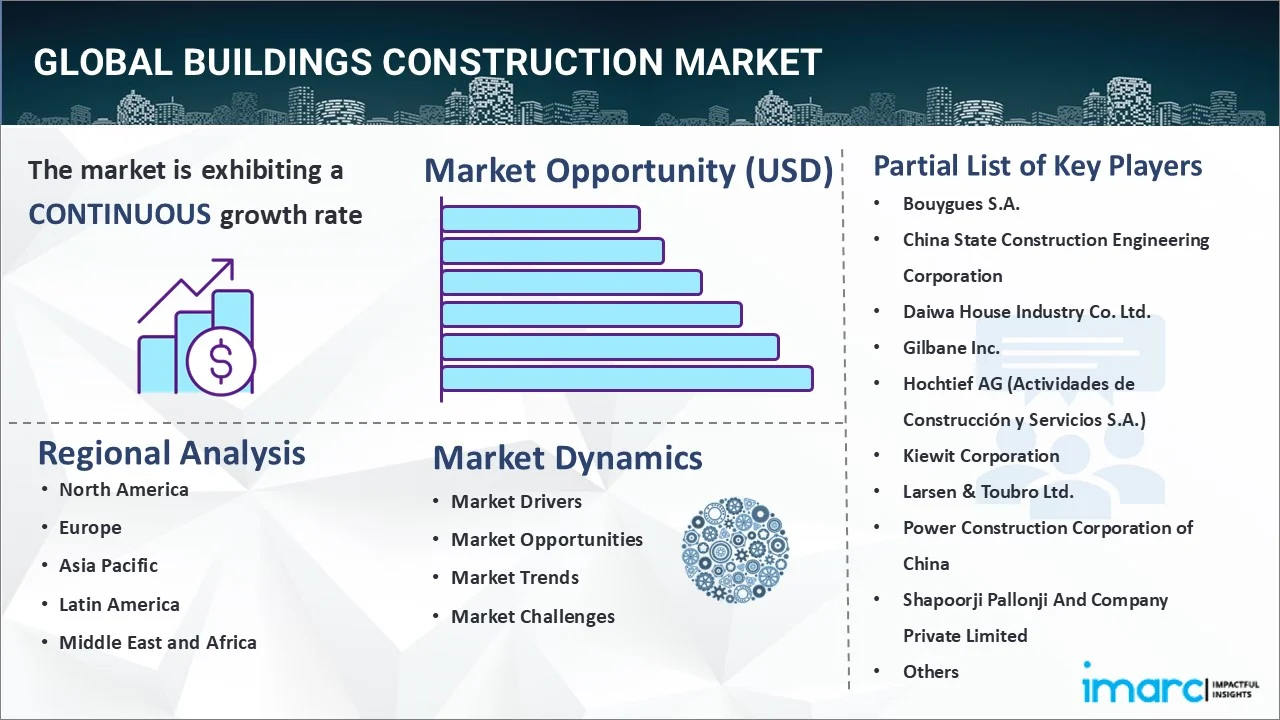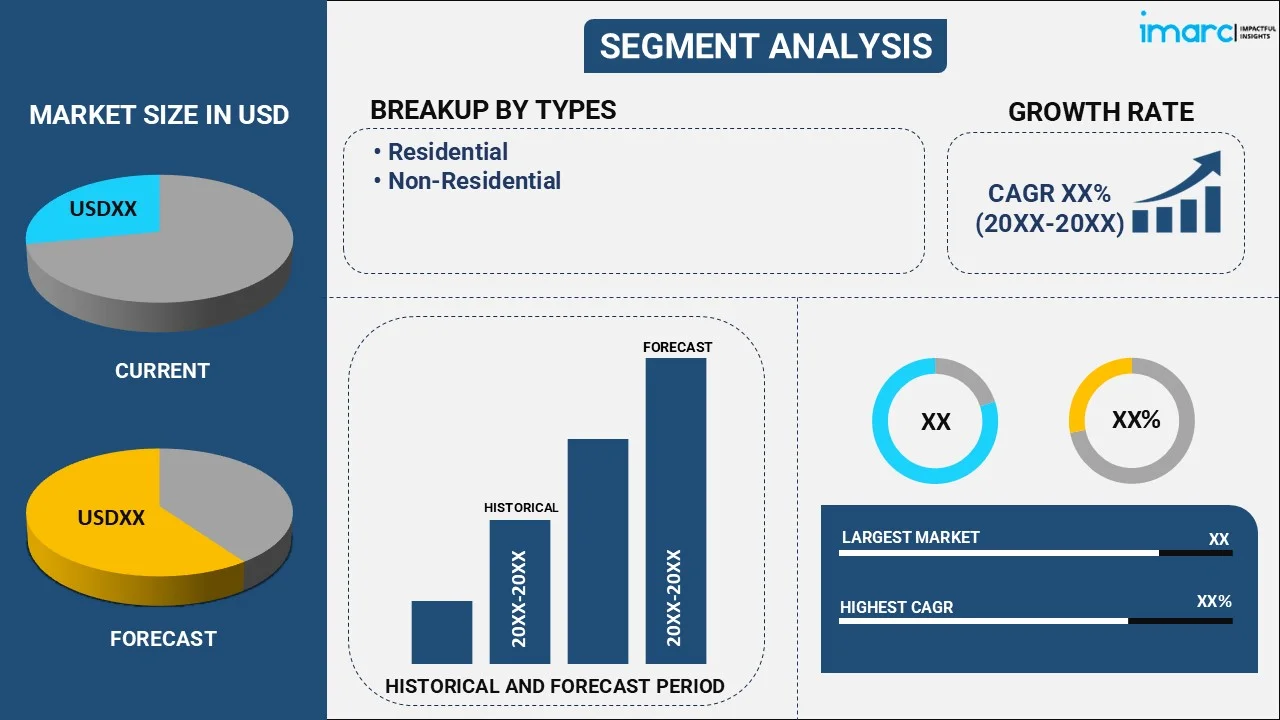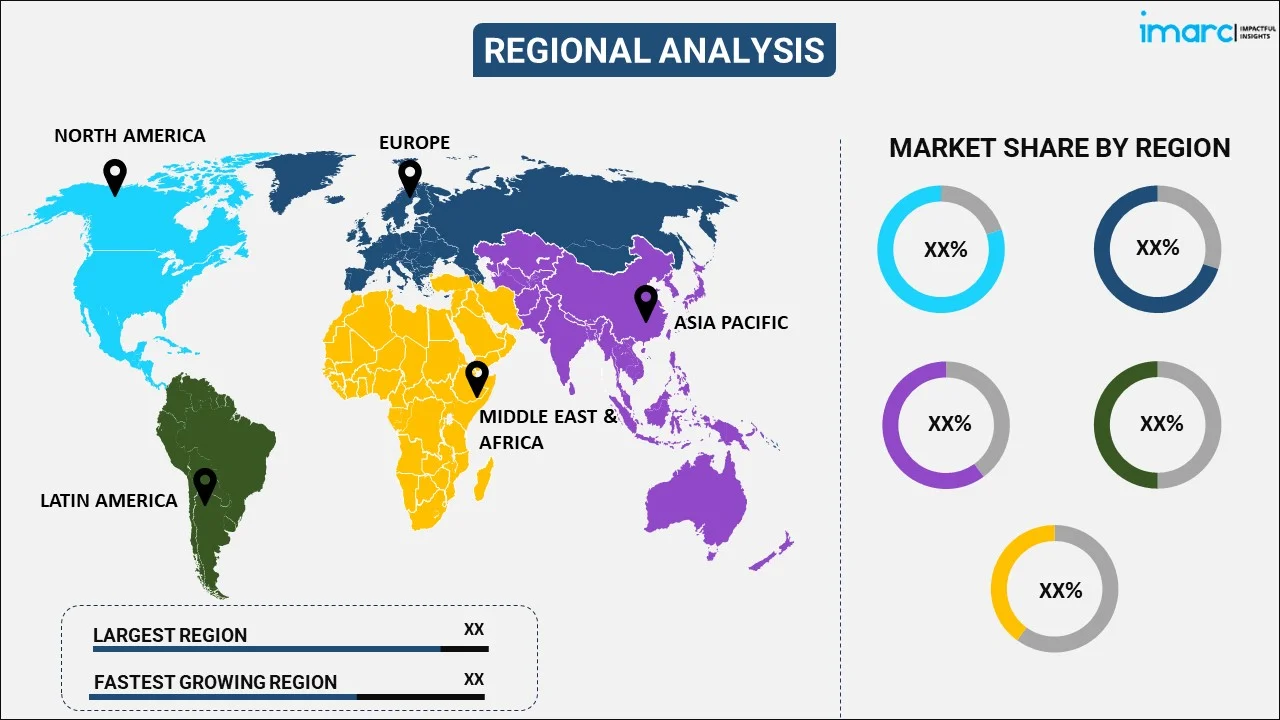
Buildings Construction Market Report by Type (Residential, Non-Residential), Construction Type (New Construction, Renovation), End User (Private, Public), and Region 2025-2033
Market Overview:
The global buildings construction market size reached USD 6.8 Trillion in 2024. Looking forward, IMARC Group expects the market to reach USD 10.5 Trillion by 2033, exhibiting a growth rate (CAGR) of 4.9% during 2025-2033. The increasing infrastructure development, the introduction of advanced technologies in construction industry, and the rising investments by government authorities in infrastructural projects such as roads, bridges, airports, and public transit systems.
|
Report Attribute
|
Key Statistics
|
|---|---|
|
Base Year
|
2024 |
|
Forecast Years
|
2025-2033 |
|
Historical Years
|
2019-2024
|
| Market Size in 2024 | USD 6.8 Trillion |
| Market Forecast in 2033 | USD 10.5 Trillion |
| Market Growth Rate (2025-2033) | 4.9% |
Building construction refers to the process of creating structures, typically for residential, commercial, or industrial purposes. It involves a series of coordinated activities, from planning and design to the actual assembly of the building. The primary goal is to create a safe, functional, and aesthetically pleasing structure. The process of building construction encompasses planning, precise execution, and rigorous quality control. It begins with the conceptualization of a design that balances form and function. As the project progresses, the construction team transforms these blueprints into tangible reality. They lay the foundations, raise the structural framework, and meticulously install intricate systems that enable modern living and working.

With a constant demand for residential, commercial, and infrastructure development, building construction industry plays a central role in shaping the urban landscape and supporting economic growth. In an ever-changing world, the market remains at the forefront, driven by factors such as rapid urbanization, environmental sustainability, and advanced construction methods. Additionally, as economies expand, businesses require more office spaces, manufacturing facilities, and logistics centers, driving construction demand, which is another major growth-inducing factor. Besides this, governments and private entities are investing in infrastructure projects, such as roads, bridges, airports, and public transit systems, to support economic growth. This, along with a diverse range of projects, from towering skyscrapers to sustainable housing developments, building construction thrives on innovation and evolving technologies. Innovations in construction technology, such as Building Information Modeling (BIM) and sustainable construction methods, drive efficiency and competitiveness in the industry. Moreover, the growing awareness about environmental issues and regulations promoting sustainable construction practices lead to increased demand for green buildings and eco-friendly materials, thus impelling market growth.
Buildings Construction Market Trends/Drivers:
Sustainable Construction Practices
Growing environmental awareness and rising focus on reducing carbon footprints have led to an increasing demand for eco-friendly buildings. This trend involves the use of energy-efficient materials, renewable energy sources, and green building certifications like LEED (Leadership in Energy and Environmental Design). Builders are integrating sustainable design principles to reduce energy consumption and minimize waste during construction. Sustainable construction aligns with environmental goals and often leads to long-term cost savings and improved occupant well-being, making it a prominent and enduring trend in the industry.
Innovations in Construction Industry
The introduction of building information modeling (BIM) has become a cornerstone in modern construction projects. BIM is a digital representation of a building's physical and functional characteristics, allowing for efficient planning, design, construction, and operation. It enhances collaboration among stakeholders, minimizes errors, and improves project efficiency. Furthermore, technologies like drones, IoT sensors, and augmented reality (AR) are being used for site inspections, safety monitoring, and real-time project management. The industry's embrace of digital tools and BIM is streamlining workflows and enhancing project outcomes.
Introduction of Prefabrication and Modular Construction Techniques
Prefabrication and modular construction techniques involve the off-site manufacturing of building components or entire modules that are then transported to the construction site for assembly. Prefabrication and modular construction offer numerous advantages, including reduced construction time, cost savings, and improved quality control. They are particularly beneficial for repetitive projects like residential housing and hotels. As technology and design innovations continue to support these methods, they are likely to become increasingly prevalent in the industry, addressing challenges related to labor shortages and project efficiency.
Buildings Construction Industry Segmentation:
IMARC Group provides an analysis of the key trends in each segment of the market report, along with forecasts at the global, regional, and country levels for 2025-2033. Our report has categorized the market based on type, construction type, and end user.
Breakup by Type:

- Residential
- Non-residential
The report has provided a detailed breakup and analysis of the market based on the type. This includes residential, and non-residential.
The global population continues to grow, leading to an increased demand for housing. This growth necessitates the construction of new residential buildings to accommodate the expanding population, driving up construction activity in the residential sector. Moreover, as more people move from rural to urban areas in search of better economic opportunities and improved living standards, there is a heightened need for urban housing and infrastructure. This trend has led to substantial residential construction in urban centers. In addition to new construction, the residential sector also includes renovation and remodeling projects. Homeowners often invest in upgrading and expanding their existing properties, further contributing to the sector's market share.
The non-residential sector includes commercial and office buildings, which are typically larger in scale than residential structures. The demand for office spaces, retail outlets, and commercial establishments is consistently high due to business expansion, urbanization, and economic growth. This drives a substantial portion of construction activity.
Breakup by Construction Type:
- New Construction
- Renovation
A detailed breakup and analysis of the market based on the construction type has also been provided in the report. This includes new construction and renovation.
New construction refers to the process of building entirely new structures or buildings from the ground up. It involves the design, planning, and construction of buildings that do not previously exist on the chosen site. New construction projects typically begin with an empty lot or land, and the construction process involves all aspects of building, including laying the foundation, erecting the structural framework, and completing interior and exterior finishes.
Renovation, also known as remodeling or refurbishment, involves making substantial modifications or improvements to existing buildings or structures. This can range from minor upgrades to comprehensive overhauls of the interior, exterior, or both. These projects can be more cost-effective than new construction, as they reuse existing infrastructure. Additionally, they can be environmentally sustainable by reducing waste and conserving resources.
Breakup by End User:
- Private
- Public
The report has provided a detailed breakup and analysis of the market based on the end user. This includes private and public.
Private segment encompasses construction projects initiated and funded by private entities, including individuals, corporations, and private organizations. Private sector building construction often involves residential properties such as houses, apartments, condominiums, and private commercial developments like office buildings, shopping centers, and industrial facilities.
The public sector involves government entities at various levels, including local, regional, and national governments. Public sector building construction covers a wide range of projects aimed at providing essential public services and infrastructure. This includes government office buildings, schools, hospitals, public transportation facilities, roads, bridges, and various other civic structures. These projects are typically funded by taxpayer money and are driven by the need to enhance public services and infrastructure.
Breakup by Region:

- North America
- United States
- Canada
- Asia Pacific
- China
- Japan
- India
- South Korea
- Australia
- Indonesia
- Others
- Europe
- Germany
- France
- United Kingdom
- Italy
- Spain
- Others
- Latin America
- Brazil
- Mexico
- Others
- Middle East and Africa
The market research report has also provided a comprehensive analysis of all the major regional markets, which include North America (the United States and Canada); Europe (Germany, France, the United Kingdom, Italy, Spain, and others); Asia Pacific (China, Japan, India, South Korea, Australia, Indonesia, and others); Latin America (Brazil, Mexico, and others); and the Middle East and Africa.
North America has a significant buildings construction market, driven by continuous urbanization, infrastructure development, and the need for modernization. In the United States, both residential and commercial construction projects play a pivotal role in the market's growth. Canada also contributes to the market, with a focus on sustainable and energy-efficient building practices.
Europe is a mature market for building construction, comprising countries like Germany, the United Kingdom, France, and Italy. The construction industry here emphasizes energy-efficient and environmentally friendly building practices, with a strong focus on sustainable and green buildings. Renovation and retrofitting of older structures are also prominent trends.
Asia Pacific encompasses countries like China, India, Japan, South Korea, and others. The region is a rapidly growing market for building construction, driven by urbanization, population growth, and robust economic development. China, in particular, stands out as a major contributor to the market, with extensive infrastructure and residential projects.
Latin American countries such as Brazil, Mexico, and Argentina are experiencing growth in the construction sector. Residential construction, along with infrastructure development, drives the market. Additionally, efforts are made to incorporate sustainable building practices.
Competitive Landscape:
The competitive landscape of the market is characterized by the presence of multiple players that include established brands, emerging startups, and specialty companies. Presently, many construction companies are expanding their service offerings to cover a broader spectrum of the construction market. This includes diversifying into residential, commercial, industrial, and institutional construction to capture a wider range of projects. They are also investing in advanced technologies to improve efficiency and productivity. This includes adopting Building Information Modeling (BIM), construction management software, drones, and automation in construction processes. Moreover, leading companies are focusing on sustainable and green construction practices. This includes using eco-friendly materials, energy-efficient designs, and sustainable building certifications like LEED.
The market research report has provided a comprehensive analysis of the competitive landscape. Detailed profiles of all major companies have also been provided. Some of the key players in the market include:
- Bouygues S.A.
- China State Construction Engineering Corporation
- Daiwa House Industry Co. Ltd.
- Gilbane Inc.
- Hochtief AG (Actividades de Construcción y Servicios S.A.)
- Kiewit Corporation
- Larsen & Toubro Ltd.
- Power Construction Corporation of China
- Shapoorji Pallonji And Company Private Limited
- Skanska AB
- STRABAG International GmbH
- Vinci SA
(Please note that this is only a partial list of the key players, and the complete list is provided in the report.)
Buildings Construction Market Report Scope:
| Report Features | Details |
|---|---|
| Base Year of the Analysis | 2024 |
| Historical Period | 2019-2024 |
| Forecast Period | 2025-2033 |
| Units | Trillion USD |
| Scope of the Report | Exploration of Historical and Forecast Trends, Industry Catalysts and Challenges, Segment-Wise Historical and Predictive Market Assessment:
|
| Types Covered | Residential, Non-Residential |
| Construction Types Covered | New Construction, Renovation |
| End Users Covered | Private, Public |
| Regions Covered | Asia Pacific, Europe, North America, Latin America, Middle East and Africa |
| Countries Covered | United States, Canada, Germany, France, United Kingdom, Italy, Spain, China, Japan, India, South Korea, Australia, Indonesia, Brazil, Mexico |
| Companies Covered | Bouygues S.A., China State Construction Engineering Corporation, Daiwa House Industry Co. Ltd., Gilbane Inc., Hochtief AG (Actividades de Construcción y Servicios S.A.), Kiewit Corporation, Larsen & Toubro Ltd., Power Construction Corporation of China, Shapoorji Pallonji And Company Private Limited, Skanska AB, STRABAG International GmbH, Vinci SA, etc. |
| Customization Scope | 10% Free Customization |
| Post-Sale Analyst Support | 10-12 Weeks |
| Delivery Format | PDF and Excel through Email (We can also provide the editable version of the report in PPT/Word format on special request) |
Key Benefits for Stakeholders:
- IMARC’s industry report offers a comprehensive quantitative analysis of various market segments, historical and current market trends, market forecasts, and dynamics of the buildings construction market from 2019-2033.
- The research report provides the latest information on the market drivers, challenges, and opportunities in the global buildings construction market.
- The study maps the leading, as well as the fastest-growing, regional markets. It further enables stakeholders to identify the key country-level markets within each region.
- Porter's five forces analysis assist stakeholders in assessing the impact of new entrants, competitive rivalry, supplier power, buyer power, and the threat of substitution. It helps stakeholders to analyze the level of competition within the buildings construction industry and its attractiveness.
- Competitive landscape allows stakeholders to understand their competitive environment and provides an insight into the current positions of key players in the market.
Key Questions Answered in This Report
The buildings construction market was valued at USD 6.8 Trillion in 2024.
IMARC estimates the buildings construction market to exhibit a CAGR of 4.9% during 2025-2033.
The buildings construction market is primarily driven by urbanization and population growth, increased demand for sustainable and energy-efficient buildings, government infrastructure investments and regulations, advancements in construction technology and materials, and rising disposable income and demand for residential and commercial spaces.
Some of the major players in the buildings construction market include Bouygues S.A., China State Construction Engineering Corporation, Daiwa House Industry Co. Ltd., Gilbane Inc., Hochtief AG (Actividades de Construcción y Servicios S.A.), Kiewit Corporation, Larsen & Toubro Ltd., Power Construction Corporation of China, Shapoorji Pallonji and Company Private Limited, Skanska AB, STRABAG International GmbH, Vinci SA, etc.
Need more help?
- Speak to our experienced analysts for insights on the current market scenarios.
- Include additional segments and countries to customize the report as per your requirement.
- Gain an unparalleled competitive advantage in your domain by understanding how to utilize the report and positively impacting your operations and revenue.
- For further assistance, please connect with our analysts.
 Request Customization
Request Customization
 Speak to an Analyst
Speak to an Analyst
 Request Brochure
Request Brochure
 Inquire Before Buying
Inquire Before Buying




.webp)




.webp)












